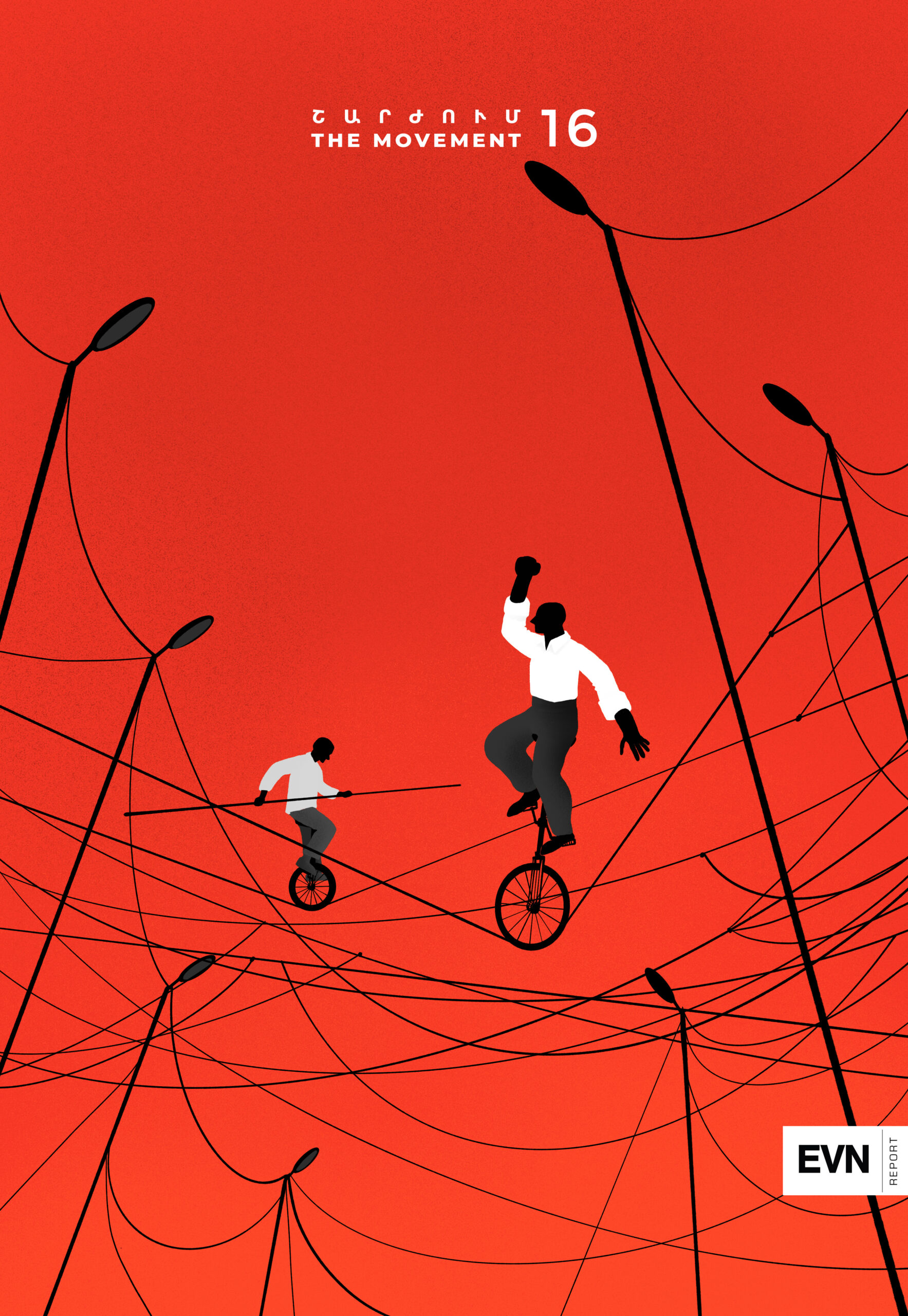

Illustration by Armine Shahbazyan
The Nagorno-Karabakh conflict still remains one of the most pressing and destabilizing issues in the post-Soviet space. Although two expansive wars have been fought over it, along with a decade of hybrid and low-intensity violence, the conflict is far from being resolved, regardless of the involvement of international organizations or the efforts of individual mediator states.
While regional and international players have their own stakes in the resolution of the conflict, there is one actor that has been involved in Karabakh since the 19th century and that country is Russia. Right now, Russia has far more leverage to influence developments in the region than other actors such as the EU and the U.S., which have been trying to find a resolution to the conflict since the 1990s. Between having peacekeepers on the ground, being the primary security provider to Armenia, and recently developing a “strategic alliance” with Azerbaijan, Russia’s expansive role in shaping and influencing facts on the ground remains unmatched. Further reinforcing Russia’s embedded influence is its newfound dominance of the OSCE Minsk Group, which Russia had secured before the 2020 war erupted.
Russia is also expanding its soft power in Artsakh. Last year, Russian was recognized as an official language in the unrecognized republic. Russian soldiers deliver humanitarian aid to the citizens of Artsakh. They visit kindergartens with toys and hold seminars and educational programs for school children. Collectively, what accounts for this posturing by Russia in Artsakh, and how can we qualify Russian interests and long-term strategic objectives with respect to this territory? It is important to examine Russia’s policy positions and long-term shifts toward the Nagorno-Karabakh conflict as the issue has become more nuanced and complicated over the decades.
For Russia, the South Caucasus is consistently regarded as an area of existential importance for its national security. Historian Sergei Markedonov argues that Russia’s approach to the Nagorno-Karabakh conflict was always highly cognizant of developments concerning Armenia, Nagorno-Karabakh and Azerbaijan, with a historic lens dating back to imperial times. In this context, Russia has always formulated its own specific approach toward the resolution of the Nagorno-Karabakh conflict, and it has always been commensurate with Armenia and Nagorno-Karabakh being important components of its southern security flank.
Russia did not detach itself from the region, even while it underwent a prolonged period of political and economic decline after the dissolution of the Soviet Union. In this context, its interests in the region have generally remained remarkably consistent. This consistent strategic approach, however, has undergone some adjustments in order to address outcomes specific to international developments, changes in foreign policy objectives, and changes to relations with the West.
Russian Policy in the Nagorno-Karabakh Conflict in the 1990s
In the 1990s, Russia’s actions toward the Nagorno-Karabakh conflict had a generally pro-Armenian stance. This was due to several factors. After the dissolution of the Soviet Union, Russia was trying to establish itself as a liberal democracy. In the early 1990s, Russian authorities welcomed warmer diplomatic relations with the U.S., as well as the efforts of the latter to assist Russia in transforming its economy and politics and integrate Russia into the Western political-economic system, which at that time Russia strived to become part of. Sergey Markedonov argues that, in the 1990s, Nagorno-Karabakh was perceived as a democracy, while Azerbaijan was not. Based on the liberal foreign policy that Russia was pursuing at the beginning of the 1990s, it could be argued that one of the conditioning factors of a more favorable Russian policy toward Armenia and Nagorno-Karabakh was the fact that Nagorno-Karabakh was an aspiring democracy.
Another crucial factor accounting for Russia’s pro-Armenia and pro-Karabakh policies were the strained relations between Boris Yeltsin, the first President of the Russian Federation, and Azerbaijani President Heydar Aliyev, who came to power in 1993. During his presidency, Yeltsin never visited Azerbaijan and continuously remained suspicious of Baku’s geopolitical aspirations. Contrary to his relations with Aliyev, Yeltsin had very warm relations with Armenia’s first president Levon Ter-Petrosyan. These interpersonal relations were crucial in influencing policy preferences, access to resources, and political cover within international settings. Thus, while Ter-Petrosyan successfully navigated his relations with Yeltsin, Aliyev faced a more detached and obstructive Kremlin.
Even before Aliyev’s tenure as strongman, Russo-Azerbaijani relations were also stuck in a phase of distrust. Abulfez Elchibey, who preceded Aliyev as president of Azerbaijan, was a staunch nationalist with an exceedingly pro-Turkish disposition and, to some extent, anti-Russian sentiments. He shifted Azerbaijan’s policy to strongly align with Turkey, thus allowing Turkey to insert itself into the South Caucasus through Azerbaijan. Such posturing by Elchibey further eroded relations with Moscow, as Azerbaijan’s pro-Turkish tilt became positively correlated with the Kremlin’s pro-Armenian positioning. Thus, Azerbaijan’s pro-Turkish tilt in the early 1990s, and Armenia’s heavily pro-Russia (and even pro-Yeltsin) posture during the same period, played an outsized role in explaining Russia’s favoritism toward Armenia.
Russia played an important role in mediating the ceasefire between Armenia, Nagorno-Karabakh and Azerbaijan in 1994. Russia made the first attempt to play the role of a mediator in the conflict, even before the USSR had officially ceased to exist. In September 1991, Boris Yeltsin and Nursultan Nazarbayev conducted a visit to the conflict zone, where they organized a meeting between the parties to the conflict. Although that first initiative toward stopping the war did not yield any results, Russia fixated its efforts on reaching a ceasefire, which would be the starting point to a political solution to the conflict. In that period, Russia was using all available channels to reach a ceasefire: the CIS, the UN and the OSCE Minsk Group. It also used its bilateral ties to convince the warring parties to stop the fighting.
Primakov argues that Russia’s objective was to find a solution that would be acceptable to all parties to the conflict. In 1996, Russia proposed the “package” solution to the Nagorno-Karabakh conflict, which entailed broad autonomy for Nagorno-Karabakh within the territory of Azerbaijan. This proposal was rejected both by Azerbaijan and Nagorno-Karabakh. After the ceasefire was signed between the conflicting parties in 1994, Russia also tried to secure the deployment of a peacekeeping mission in the region, but the idea was rejected by both Yerevan and Baku. When Russia failed to advance its own proposal, the Minsk Group offered a “step-by-step” solution, in which the status of Karabakh would be decided after other issues such as the formation of a security zone around Nagorno-Karabakh and the return of refugees, as well as the deployment of international peacekeepers, were solved. The proposals of the Minsk Group also entailed the deployment of international, not Russian, peacekeepers.
Collectively speaking, it is fairly evident that Russia was never going to accept the independence of Nagorno-Karabakh. At the same time, it was also not going to accept a development where Nagorno-Karabakh was going to be fully absorbed into Azerbaijan. While seemingly contradictory, Russia’s overarching strategy was quite intuitive: creating a structure of dependence with Russia as ultimate arbiter.
Russian Policy in the Nagorno-Karabakh Conflict at the Beginning of the 2000s
In the 1990s, two figures played a prominent role in shaping Russia’s foreign policy. One of them was liberal-minded Andrei Kozyrev, who steered Russia toward integration and close political-economic cooperation with the West. However, by 1993, there was a backlash against Kozyrev’s ideas, as many in Russia grew impatient with the West’s delivery on its promises. This is when some circles in Russia started to think that Russia should adopt a more Eurasia-centric policy. The forerunner for this policy was Yevgenii Primakov, who replaced Kozyrev as Foreign Affairs Minister in 1996. The appointment of Primakov signaled that Russia was starting to pursue a grand strategy worthy of a world power, thus replacing a Western-oriented foreign policy with a Eurasia-oriented one.[1][3]
With this shift in foreign policy orientation, Russia had to try to mend relations with Azerbaijan and consider Azerbaijan’s interests as well, which led to a Russian regional policy less favorable toward Armenia and more balanced between the conflicting parties.
Russia’s aspirations to re-assert itself as a regional power and to push forward its own interests on its periphery took final shape at the beginning of the 2000s, with the accession to the presidency of Vladimir Putin. This is when latent pro-Armenian attitudes toward the Nagorno-Karabakh conflict started to change.
Although Armenia had a pro-Russian disposition since its independence, especially under President Serzh Sargsyan (2008-2018), Armenia had implemented a policy of complementarity, in which it tried to balance its relations with Russia and the West, stipulating that having good relations with Russia and the West were not mutually exclusive. In this regard, up until 2013, there was still room for competition to Russian interests in Armenia. However, with Armenia’s integration into the EAEU in 2013, Russia further strengthened its position in Armenia, which allowed it to further dictate terms and pursue its own interests in the Nagorno-Karabakh conflict.
Factors Driving Changes in Azerbaijani-Russian Relations
Azerbaijan remains an important ally for Turkey in the region and represents Turkey’s interests. Thus, Russia needs to assert influence on Azerbaijan in order to be able to mitigate the dangers that might come from growing Turkish influence in its “near abroad”, which includes Central Asia. In this regard, Russia must balance its relations with Azerbaijan and Turkey, while also sustaining its partnership with Armenia.
In 2011, Azerbaijan joined the Non-Aligned Movement, which prohibits it joining any military blocs. Despite close relations with Moscow, this move by Azerbaijan can also be regarded as a signal to Russia that Azerbaijan does not intend to fall under Russian influence. While Russia regards the South Caucasus as one of the most important regions for its national interests, it is Armenia with which Russia has the strongest relations, considering Georgia’s pro-Western orientation after the 2003 Rose Revolution and Azerbaijan’s continuous strengthening of relations with Turkey.[4]
Nonetheless, there are several factors that ensure mutual benefits for Russia and Azerbaijan from their bilateral relations. They have common interests and effective economic cooperation in the Caspian Sea region. Azerbaijan is also an important customer of Russian arms, which Baku employs to compensate Moscow for Azerbaijan’s pro-Western energy policy. Similarly, by selling arms to Azerbaijan, Russia also demonstrates the preservation of balance between its relations with Armenia and Azerbaijan in regard to the Nagorno-Karabakh conflict.
This also demonstrates that Russia adopted a policy toward Nagorno-Karabakh that specifically suited its own interests more than those of Armenia. In this context, the question of self-determination for the Armenians of Artsakh became more and more improbable, for such a development would qualify a resolution to the conflict that was not commensurate with Russia’s regional interests. Since Russia’s posture has been neither self-determination nor Azerbaijani absorption, this state of purgatory that Nagorno-Karabakh has found itself in remains defined by Russia as the ultimate arbiter. And as the ultimate arbiter, a Russian military presence on the ground is a foregone conclusion.
Despite mutual interests, there are also issues in Russian-Azerbaijani relations. Azerbaijan aspires to become a major actor in regional energy projects and a partner with the West, which contradicts Russian interests as a competitor. Another important factor diverging Russian and Azerbaijani relations is that Azerbaijan supports the territorial integrity of both Georgia and Ukraine. Azerbaijan and Ukraine are bound with a multi-layered partnership; both countries are part of GUAM, a regional organization established by Georgia, Ukraine, Azerbaijan and Moldova in 1997 to foster economic, diplomatic and military relations among themselves. Ukraine is also a major arms provider to Azerbaijan, while the latter supplies gas and oil to Ukraine. Ukraine has also repeatedly voiced its support for Azerbaijan’s territorial integrity. Given these circumstances, it is not surprising that, on March 27, 2014, Azerbaijan voted in favor of the UN resolution supporting Ukraine’s territorial integrity and condemning Russia’s annexation of Crimea.
And finally, Azerbaijan, at this point, has no intention of joining Eurasian integration projects initiated by Russia, which would lend Russia greater influence over Azerbaijan.
Russian Aspirations and Changes of Power Dynamics Within the Minsk Group
In 2014, 2015 and 2016, Russia updated its Military Doctrine, National Security Strategy and Foreign Policy Concept, respectively. The changes in these documents are manifest in Russia’s growing ambitions for power projection by challenging the Euro-Atlantic security order.[4] The changes reveal Russia’s protests that the international security system did not ensure security for all states, that modern communication technologies are used to manipulate public opinion in different countries, and that NATO expansion in Eastern Europe and the South Caucasus is a direct threat to Russia’s national interests.
These changes were also apparent in Russia’s growing role within the OSCE Minsk Group. While Russia and the Western powers have differing interests and disputes in most parts of the world, the Nagorno-Karabakh issue was one of the few areas where they have been cooperating since the 1990s. However, this has not hindered Russia from mediating the conflict on its own initiative and thus seeking to dictate terms. Moreover, it may appear that France and the U.S. have agreed to allow Russia to take the initiative in spearheading the negotiation process.
Russia’s role in the settlement of the Nagorno-Karabakh conflict within the OSCE Minsk Group increased with the Western powers losing interest in the region. The EU had to deal with other problems, such as the UK leaving the union and a migration crisis. After Russia’s aggression against Ukraine in 2014, the West seems even more reluctant to irritate Russia in the Caucasus.[4] The influence of the EU and the U.S. in the South Caucasus was weakened after 2014; the EU has resorted to offering economic incentives and diplomatic assistance, while the U.S., beginning with the Obama Administration and continuing with the Trump presidency, has de-prioritized the South Caucasus as a region of strategic interest.[4]
Although Russia did not steer away from its approaches to the solution of the conflict and from the principles supported by the Minsk Group, it did however introduce a new format of negotiation, offering tripartite meetings with the participation of the Russian, Armenian and Azerbaijani leaders. On numerous accounts, the Russian president mediated a meeting between the leaders of Armenia and Azerbaijan outside the framework of the Minsk Group.
The Nagorno-Karabakh conflict intensified in 2014 and reached a major escalation in 2016, which ended after four days of heavy fighting on the Line of Contact, as well as on the internationally recognized border between Armenia and Azerbaijan. These were the largest clashes in the conflict zone after the ceasefire in 1994. After the 2016 Four Day April War, it had become clear that a larger escalation might be inevitable and that other actors, such as Turkey, might get militarily involved in the conflict.
On the eve of the eruption of hostilities in April 2016, Armenia’s President Serzh Sargsyan and Azerbaijan’s President Ilham Aliyev had held separate meetings with U.S. Vice President Joe Biden on April 1, within the framework of the Nuclear Security Summit held in Washington, D.C. The eruption of renewed hostilities between the conflicting parties cast a shadow on U.S. efforts to resolve the conflict. On April 5, Russia brokered a cease-fire between Armenia and Azerbaijan, demonstrating that it can settle the conflict according to its own terms without the other OSCE Minsk Group co-chairs.
Before the 2016 Four Day April War, Russia again had proposed to Armenia and Azerbaijan that it deploy its peacekeeping forces in the region, especially in 2015 under the Lavrov Plan.[4] At that time, both Armenia and Azerbaijan rejected the offer. This clearly undermined Russian interests in the region, while also contradicting Russia’s broader strategy of dictating terms in the South Caucasus.The 2020 Artsakh War clearly changed this; while both parties had, since 1994, rejected Russian offers of stationing peacekeepers, both parties now agreed to have a Russian military presence in Nagorno-Karabakh.
Conclusion
Even after the dissolution of the Soviet Union, Russia continued to articulate its interests in the South Caucasus as part of its sphere of influence. Although Russia’s interests in the region more or less remained the same, as Russia got stronger and asserted itself as a regional power, its approach toward safeguarding its interests in the region changed. Since the signing of the ceasefire in 1994, the status quo of the Nagorno-Karabakh conflict suited Russia, enabling it to exercise leverage in the region.
The 2020 Artsakh War, however, altered the status quo, shifting the balance of power between Armenia and Azerbaijan. To accommodate this shattering of the ante bellum status quo, Russia re-instituted a new status quo, featuring the presence of Russian troops. While there was previously no Russian military presence on Armenia’s eastern borders, now there are Russian peacekeepers in Artsakh and there are talks of deploying Russian border guards on the Armenian-Azerbaijani border. If the demarcation and delimitation process starts between Armenia and Azerbaijan, and the process progresses as Armenia suggests, with the withdrawal of both armies from the borderline and the deployment of international peacekeepers until the process is complete, there might be additional Russian troops deployed on the border. This will reconfirm Russia’s posture as the pre-eminent force in the South Caucasus.
Footnotes
[1] Allen C Lynch (2002). The Evolution of Russian Foreign Policy in the 1990s, Journal of Communist Studies and Transition Politics, 18:1, 161-182.
[2] Shirinyan, Anahit (2013). Assessing Russia’s Role in Efforts to Resolve the Nagorno-Karabakh Conflict: From Perception to Reality. Caucasus Edition: Journal of Conflict Transformation.
[3] Matthew Sussex (2012). Twenty years after the fall: continuity and change in Russian foreign and security policy, Global Change, Peace & Security, 24, 203-217.
[4] Hedenskog et al (2008). Security in the Caucasus: Russian policy and military posture, Swedish Defense Research Agency.


The Diasporan Response to the Karabakh Movement: The Case of France
How did the Armenian community in France live the events of 1988? What were the challenges faced in the diaspora and what were the main debates over the question of Armenia’s independence?
Read moreThe 1988 Karabakh Movement and the Imperative for a New Artsakh Narrative
While the Karabakh Movement led to a national reawakening, the situation today is vastly different. What does the future hold for Artsakh, and has Armenia lost agency in resolving the issue that has been the cornerstone of Armenian statehood?
Read moreRelated articles
The Slogans, Posters and Language of the Karabakh Movement
One of the distinctive characteristics of the Karabakh Movement was that in less than three years, it drastically changed how the Soviet value system was perceived. The visual and verbal manifestation of this was evident through the transformation of the language and texts of the posters and signs used during the Movement.
Read moreThe Karabakh Movement and Azerbaijan
Tatevik Hayrapetyan writes that the Karabakh Movement was a catalyst for domestic developments in Azerbaijan. Unlike in Armenia, however, alternative forces like the Azerbaijani Popular Front in Azerbaijan, couldn’t find a way to collaborate with the local Communist Party. The issue of Karabakh and anti-Armenian propaganda was thereby used in their struggle against the Communist regime.
Read moreThere is Now a Statue of a Dove in Sumgait
Deciding never to use the word Genocide and then coming face-to-face with it again in a new context; between reading biographies of the victims of the Sumgait Pogrom over and over again and the urge to see who now occupies the homes of the Armenians of Baku and Sumgait, writer Lusine Hovhannesyan unexpectedly discovers a common yet obvious thread.
Read moreThe Karabakh Movement or What was Happening in Soviet Armenia 30 Years Ago
Harutyun Marutyan writes that the Karabakh Movement was not only the first of the Eastern European revolutions, but it played a considerable role in the democratization of Soviet society, was pivotal in the deconstruction of the Soviet Union and consequently in the elimination of the threat of communism.
Read moreHow It All Began: The Soviet Nationalities Policy and the Roots of the Karabakh Problem
Long before the first rallies and clashes over the territory of Nagorno Karabakh, there were several signs of the coming storm writes Mikayel Zolyan. One of these was the “war of memory,” waged not by soldiers, but in the sphere of historiography.
Read moreKarabakh Movement 88: A Chronology of Events on the Road to Independence
The Karabakh Movement was a crystallizing moment in the collective and historical memory of the Armenian nation. In this first in a series of articles about the Movement, EVN Report presents a chronology of the events of 1988 which eventually paved the way to independence.
Read more









